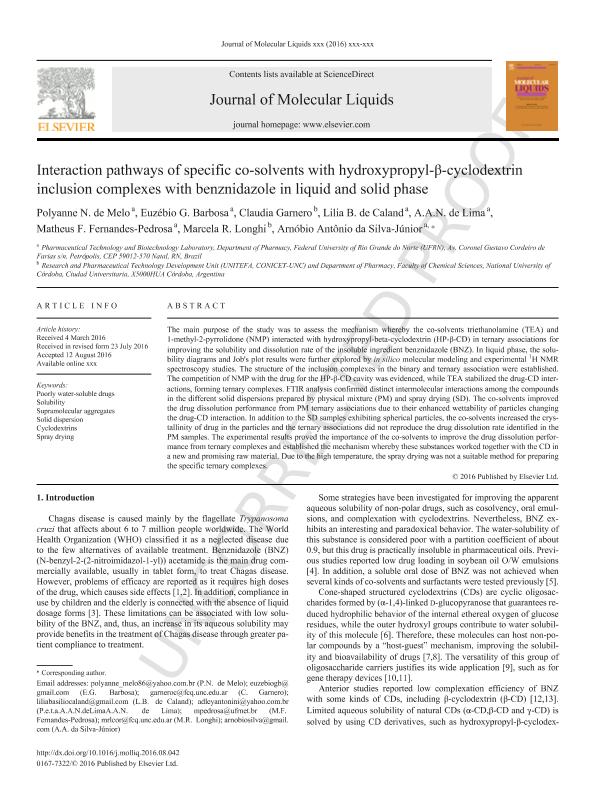Mostrar el registro sencillo del ítem
dc.contributor.author
de Melo, Polyanne N.
dc.contributor.author
Barbosa, Euzébio G.
dc.contributor.author
Garnero, Claudia

dc.contributor.author
de Caland, Lilia B.
dc.contributor.author
Fernandes Pedrosa, Matheus F.
dc.contributor.author
Longhi, Marcela Raquel

dc.contributor.author
da Silva Júnior, Arnóbio Antônio
dc.date.available
2018-10-25T17:11:47Z
dc.date.issued
2016-11
dc.identifier.citation
de Melo, Polyanne N.; Barbosa, Euzébio G.; Garnero, Claudia; de Caland, Lilia B.; Fernandes Pedrosa, Matheus F.; et al.; Interaction pathways of specific co-solvents with hydroxypropyl-β-cyclodextrin inclusion complexes with benznidazole in liquid and solid phase; Elsevier Science; Journal of Molecular Liquids; 223; 11-2016; 350-359
dc.identifier.issn
0167-7322
dc.identifier.uri
http://hdl.handle.net/11336/63056
dc.description.abstract
The main purpose of the study was to assess the mechanism whereby the co-solvents triethanolamine (TEA) and 1-methyl-2-pyrrolidone (NMP) interacted with hydroxypropyl-beta-cyclodextrin (HP-β-CD) in ternary associations for improving the solubility and dissolution rate of the insoluble ingredient benznidazole (BNZ). In liquid phase, the solubility diagrams and Job's plot results were further explored by in silico molecular modeling and experimental 1H NMR spectroscopy studies. The structure of the inclusion complexes in the binary and ternary association were established. The competition of NMP with the drug for the HP-β-CD cavity was evidenced, while TEA stabilized the drug-CD interactions, forming ternary complexes. FTIR analysis confirmed distinct intermolecular interactions among the compounds in the different solid dispersions prepared by physical mixture (PM) and spray drying (SD). The co-solvents improved the drug dissolution performance from PM ternary associations due to their enhanced wettability of particles changing the drug-CD interaction. In addition to the SD samples exhibiting spherical particles, the co-solvents increased the crystallinity of drug in the particles and the ternary associations did not reproduce the drug dissolution rate identified in the PM samples. The experimental results proved the importance of the co-solvents to improve the drug dissolution performance from ternary complexes and established the mechanism whereby these substances worked together with the CD in a new and promising raw material. Due to the high temperature, the spray drying was not a suitable method for preparing the specific ternary complexes.
dc.format
application/pdf
dc.language.iso
eng
dc.publisher
Elsevier Science

dc.rights
info:eu-repo/semantics/openAccess
dc.rights.uri
https://creativecommons.org/licenses/by-nc-nd/2.5/ar/
dc.subject
Cyclodextrins
dc.subject
Poorly Water-Soluble Drugs
dc.subject
Solid Dispersion
dc.subject
Solubility
dc.subject
Spray Drying
dc.subject
Supramolecular Aggregates
dc.subject.classification
Nano-materiales

dc.subject.classification
Nanotecnología

dc.subject.classification
INGENIERÍAS Y TECNOLOGÍAS

dc.title
Interaction pathways of specific co-solvents with hydroxypropyl-β-cyclodextrin inclusion complexes with benznidazole in liquid and solid phase
dc.type
info:eu-repo/semantics/article
dc.type
info:ar-repo/semantics/artículo
dc.type
info:eu-repo/semantics/publishedVersion
dc.date.updated
2018-10-23T13:42:51Z
dc.journal.volume
223
dc.journal.pagination
350-359
dc.journal.pais
Países Bajos

dc.journal.ciudad
Amsterdam
dc.description.fil
Fil: de Melo, Polyanne N.. Universidade Federal do Rio Grande do Norte; Brasil
dc.description.fil
Fil: Barbosa, Euzébio G.. Universidade Federal do Rio Grande do Norte; Brasil
dc.description.fil
Fil: Garnero, Claudia. Consejo Nacional de Investigaciones Científicas y Técnicas. Centro Científico Tecnológico Conicet - Córdoba. Unidad de Investigación y Desarrollo en Tecnología Farmacéutica. Universidad Nacional de Córdoba. Facultad de Ciencias Químicas. Unidad de Investigación y Desarrollo en Tecnología Farmacéutica; Argentina
dc.description.fil
Fil: de Caland, Lilia B.. Universidade Federal do Rio Grande do Norte; Brasil
dc.description.fil
Fil: Fernandes Pedrosa, Matheus F.. Universidade Federal do Rio Grande do Norte; Brasil
dc.description.fil
Fil: Longhi, Marcela Raquel. Consejo Nacional de Investigaciones Científicas y Técnicas. Centro Científico Tecnológico Conicet - Córdoba. Unidad de Investigación y Desarrollo en Tecnología Farmacéutica. Universidad Nacional de Córdoba. Facultad de Ciencias Químicas. Unidad de Investigación y Desarrollo en Tecnología Farmacéutica; Argentina
dc.description.fil
Fil: da Silva Júnior, Arnóbio Antônio. Universidade Federal do Rio Grande do Norte; Brasil
dc.journal.title
Journal of Molecular Liquids

dc.relation.alternativeid
info:eu-repo/semantics/altIdentifier/doi/http://dx.doi.org/10.1016/j.molliq.2016.08.042
dc.relation.alternativeid
info:eu-repo/semantics/altIdentifier/url/https://www.sciencedirect.com/science/article/pii/S0167732216305384
Archivos asociados
